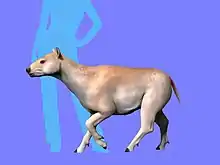| Promacrauchenia | |
|---|---|
| Scientific classification | |
| Domain: | Eukaryota |
| Kingdom: | Animalia |
| Phylum: | Chordata |
| Class: | Mammalia |
| Order: | †Litopterna |
| Family: | †Macraucheniidae |
| Subfamily: | †Macraucheniinae |
| Genus: | †Promacrauchenia Ameghino, 1904 |
| Type species | |
| †Promacrauchenia antiqua Ameghino, (1889) | |
| Other species | |
| |
| Synonyms | |
|
Macrauchenia antiqua Ameghino 1889 | |
Promacrauchenia is an extinct genus of macraucheniids that lived during the Late Miocene to Late Pliocene epochs of what is now Argentina and Bolivia. It belongs to the subfamily Macraucheniinae, which also includes Huayqueriana, Macrauchenia, and Xenorhinotherium.[1][2][3] Fossils of this genus have been found in the Ituzaingó, Andalhuala, and Cerro Azul Formations of Argentina.
Classification
The genus Promacrauchenia was first described by Florentino Ameghino in 1904, on the basis of fossils found in Patagonia in lower Pliocene deposits and which Ameghino himself, years earlier, had described as a species of Macrauchenia, as M. antiqua . In addition to the type species, Promacrauchenia antiqua, other species have been assigned to this genus: P. calchaquiorum, P. chapadmalense, P. ensenadense, P. kraglievichi and P. yepesi.
Promacrauchenia was a member of the Macraucheniidae, a group of litopterns whose evolution led to the development of camel-like forms with strange nasal bones. Promacrauchenia, in particular, was a specialized macraucheniid, perhaps directly ancestral to genera such as Macrauchenia and Windhausenia.[3]
The following cladogram of the Macraucheniidae is based on McGrath et al. 2018, showing the position of Promacrauchenia.[4]
| |||||||||||||||||||||||||||||||||||||||||||||||||||||||||||||||||||||||||||||||||||||||||||||||||||||||||||||||||||||||||||||||
References
- ↑ "Fossilworks: Promacrauchenia". www.fossilworks.org. Retrieved 2022-04-29.
- ↑ Schmidt, Gabriela I.; Ferrero, Brenda S. (2014-07-29). "Taxonomic reinterpretation of Theosodon hystatus Cabrera and Kraglievich, 1931 (Litopterna, Macraucheniidae ) and phylogenetic relationships of the family". Journal of Vertebrate Paleontology. 34 (5): 1231–1238. Bibcode:2014JVPal..34.1231S. doi:10.1080/02724634.2014.837393. hdl:11336/18953. ISSN 0272-4634. S2CID 86091386.
- 1 2 Analía M. Forasiepi; Ross D. E. MacPhee; Santiago Hernández del Pino; Gabriela I. Schmidt; Eli Amson; Camille Grohé (2016). "Exceptional skull of Huayqueriana (Mammalia, Litopterna, Macraucheniidae) from the late Miocene of Argentina: anatomy, systematics, and paleobiological implications" (PDF). Bulletin of the American Museum of Natural History. 404: 1–76. doi:10.1206/0003-0090-404.1.1. hdl:2246/6659. S2CID 89219979.
- ↑ Andrew J. McGrath; Federico Anaya; Darin A. Croft (2018). "Two new macraucheniids (Mammalia: Litopterna) from the late middle Miocene (Laventan South American Land Mammal Age) of Quebrada Honda, Bolivia". Journal of Vertebrate Paleontology. 38 (3): e1461632. Bibcode:2018JVPal..38E1632M. doi:10.1080/02724634.2018.1461632. S2CID 89881990.




.jpg.webp)



